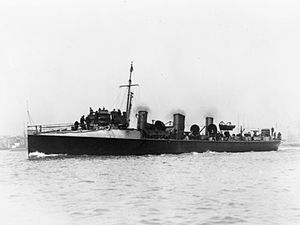HMS Bat (1896)

HMS Bat
|
|
| History | |
|---|---|
|
|
|
| Name: | HMS Bat |
| Ordered: | 8 January 1896 |
| Builder: | Palmers Shipbuilding and Iron Company, Jarrow |
| Laid down: | 28 May 1896 |
| Launched: | 7 October 1896 |
| Commissioned: | August 1897 |
| Out of service: | Laid up in reserve, 1919 |
| Fate: | Sold for breaking, 10 June 1919 |
| General characteristics | |
| Class and type: | Palmer three funnel - 30 knot destroyer |
| Displacement: |
|
| Length: | |
| Beam: | 20 ft 9 in (6.32 m) |
| Draught: | 12 ft 5.5 in (3.797 m) |
| Installed power: | 6,200 ihp (4,600 kW) |
| Propulsion: |
|
| Speed: | 30 kn (56 km/h) |
| Complement: | 63 officers and men |
| Armament: |
|
| Service record | |
| Operations: | World War I 1914 - 1918 |
HMS Bat was a Palmer three funnel, 30 knot destroyer ordered by the Royal Navy under the 1895 – 1896 Naval Estimates. She was the third ship to carry this name since it was introduced in 1815 for a revenue cutter in service until 1848.
HMS Bat was one of four 30-knotter destroyers (Bat, Chamois, Crane and Flying Fish) ordered from Palmer's of Jarrow on 8 January 1896 as part of the 1895–1896 shipbuilding programme, following on from two destroyers (Star and Whiting) ordered from Palmer's on 23 December 1895 as part of the same programme.
She was laid down on 28 May 1896 at the Palmer shipyard at Jarrow-on-Tyne and launched on 7 October 1896. During her builder’s trials she made her contracted speed requirement. She was completed and accepted by the Royal Navy in August 1897.
After commissioning Bat was assigned to the 2nd Fleet and based at Devonport on training duties.
In October 1898, the ship became the first destroyer in the Royal Navy to receive a torpedo fitted for a gyroscope.
In 1899 she was the leader of the Devonport Flotilla under the command of Commander Alexander Ludovic Duff during exercises in July. Commander Pennant Lloyd was appointed in command in January 1900. The following month she had her starboard propeller damaged while in the Falmouth harbour, when the destroyer Fairy dragged her moorings and drifted into Bat and other ships of the flotilla. Following repairs in Devonport, she was to go back to the flotilla, but had to withdraw for a longer period as there was an accident in the enigne-room during power trials in late February. She paid off into the Dockyard reserve at Devonport on 8 March 1900. Her next commanding officer, from 1901, was Commander Roger Keyes, who pioneered new aggressive tactics for destroyers during this period. Bat was paid off on 4 January 1902, when her crew was turned over to the destroyer Falcon, which took her place in the Flotilla. After paying off, she underwent repairs to re-tube her Reed boilers.
...
Wikipedia
